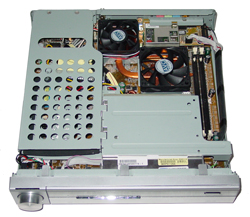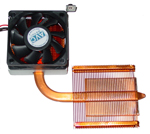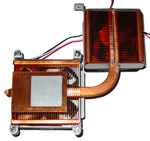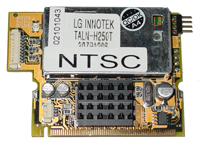Asus DigiMatrix - The Pizza Box Form Factor
by Andrew Ku on February 11, 2004 1:41 PM EST- Posted in
- Systems
Construction - Under the Hood
Despite its small profile, Asus has decided to employ the DigiMatrix on a 533FSB Pentium 4 platform. This choice is more of one due to a lack of options. When it comes to MPEG encoding operations and tasks of the multimedia variety, Pentium 4 processors are more favorable over the Athlon XPs. An 800FSB Pentium 4 platform would no doubt increase the cost of the system because of the chipset, processor, and memory used. This is atop the increased thermal budget. So, it was perfectly natural to expect Asus to choose a 533FSB Pentium 4 platform base, no doubt based on a SiS chipset because of price reasons.The CPU socket is in the upper right hand corner of the motherboard. The heatsink can be removed via four screws that secure it to the motherboard and one to the backside of the system.
There is a riser card that is somewhat in the way of installing/uninstalling the CPU and memory, which can be unhinged via two screws that hold it in place to the back frame. The riser card itself is home to the radio module that seems to be manufactured by Nigata Semitsu, who also manufactures the radio module on the MSI Mega PCs.
The copper heatsink interfaces with the CPU with the help of some thermal adhesive, which seems to be of the epoxy variety.
Due to the design of the DigiMatrix, Asus had to build its motherboard to utilize notebook components, e.g. mini-PCI, instead of the full size PCI form factor.
There are two mini-PCI slots on the DigiMatrix motherboard, one on the top and one on the bottom. A TV tuner manufactured by Lifeview populates the mini-PCI slot on the top of the motherboard. This is definitely one of the smallest TV tuners that we have seen, but the question still remains to be that of quality. Manufacturing the smallest TV tuner isn't quite an accomplishment, unless it actually produces comparable quality to TV tuners of the PCI form factor.

The second mini-PCI slot is situated on the bottom side of the motherboard and is populated by Asus' 802.11b WiFi card. The card is powered by Ralink's RT2460P 802.11b chipset.
The WiFi antenna is fixed directly behind and below the volume dial, but it is inaccessible due to the front cover.


















16 Comments
View All Comments
mindless1 - Thursday, February 12, 2004 - link
LOL, it's just wastefull to design a box big enough for RAID 0+1, and MPEG2 certainly does not need (even) modern HDD performance levels.It was a nice review, but I'd have to disagree with one part- It is not desirable to decrease the size of the power supply. Make it too small and it's going to have high heat density, lower reserve capacity, and overall less quality in the design. It IS possible to use very high quality and more exotic parts to decrease size, at about 3X the cost.
I agree that it would be very nice if the remote had a touchpad on it, similar to that on a notebook.
One thing I wish Asus had done differently, is to find a way to make more of the front panel ports, or at least the DVD tray, accessible without opening that front hatch. I imagine my hatch would always stay open just so I didn't have to open/close for something as simple as loading a DVD.
Doormat - Wednesday, February 11, 2004 - link
I've been looking at SFF/HTPC like boxes, but my biggest gripe is that they only have 1 or 2 spots for a hard drive. When I build a HTPC, I'd want more than 2 HD spaces (preferably 4 SATA connectors w/ bays). That prolly wont make it a SFF box, but a Tivo-size box could provide for that. The idea is that 4x200GB in RAID 0+1 would provide enough for recording TV in HD/SD MPEG-2 as well as ripping DVDs and storing them, plus other misc stuff. None of the products on the market can suit me and look nice...AlabamaEnigma - Wednesday, February 11, 2004 - link
It's not a bad little box, but I prefer their new T2-P Deluxe. It has MOST of the features of the DigiMatrix, but uses the i865G chipset and has 8X AGP. It's also a lot cheaper.3Suns - Wednesday, February 11, 2004 - link
It doesn't come with a hard drive, processor, or memory. It's a barebones system. And the 533 MHz refers to the FSB.for $400 I actually think it's kind of a bargain. Nice case with a volume knob and case buttons and an LCD, motherboard, video capture card, radio tuner, tv tuner, gigabit ethernet, wireless ethernet, DVD/CD-RW, separately powered MP3 player, 7-in-1 card reader...
I'm seriously considering putting together a sub-$1000 system and trying to get it running as a personal Linux fileserver/media station. Wish me luck!
ChemMan - Wednesday, February 11, 2004 - link
I think by 533 Mhz they mean the fsb, not the clock speed of the processor.Jeff7181 - Wednesday, February 11, 2004 - link
Am I reading this right?It doesn't come with a hard drive? Not even a tiny little 20 or 40 GB drive to get someone started using it as a Tivo type of thing? For $400 the least they can do is stick a little 20 GB 5400 RPM hard drive in there... sheesh.
Call me crazy, but shouldn't you be able to passively cool a 533 Mhz Pentium 4? I mean... a Pentium 4 @ 533 Mhz is probably creating what... 10-15 watts of heat? I was shocked to see what looks like a heatpipe and two large fans in there... looks like a very poor cooling design to me.